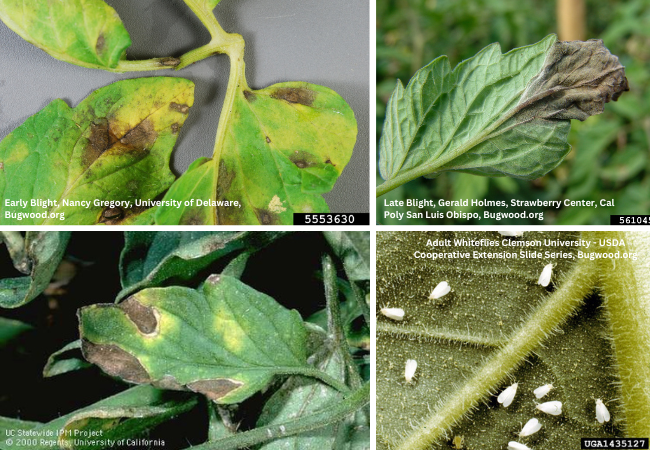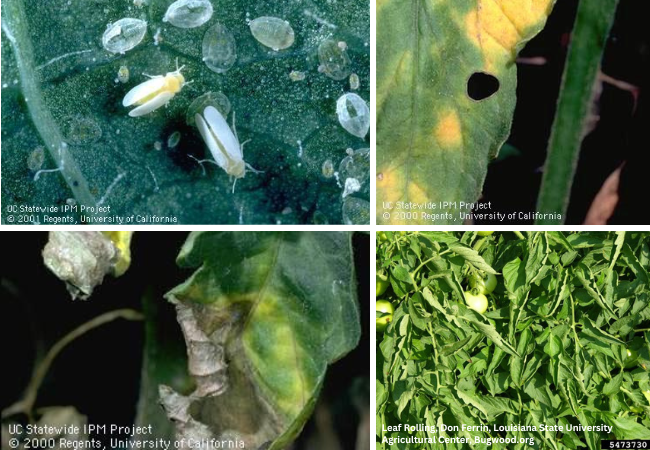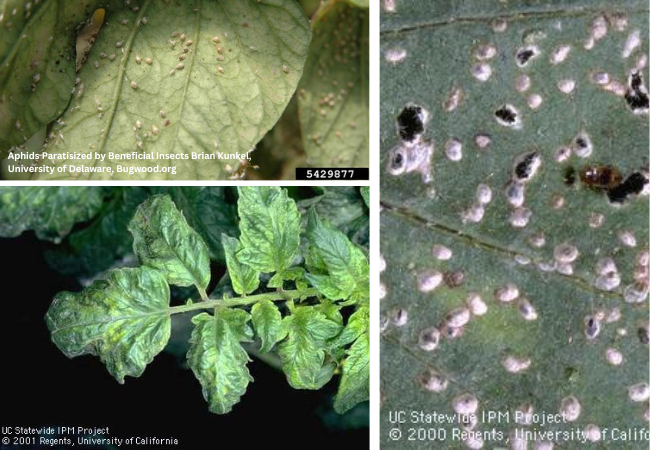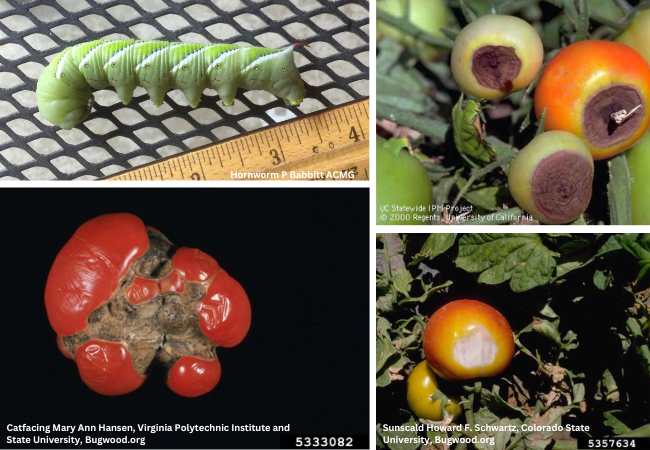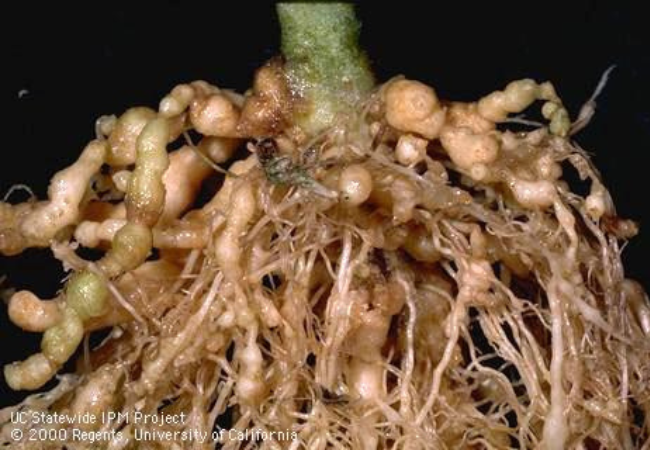Tomatoes are one of our most popular and best-loved garden plants, but they do have their issues, which vary depending on variety, climate, soil, time of the season and your overall garden environment. Problems may happen despite the best care you can give them. This blog focuses on managing tomato problems common in Alameda County in mid-summer.
The problems are sorted by where you will first see it appear on the plant. The problem may also cause symptoms on other parts of the plant.
Tomato Problems Seen on Leaves
Early blight
-
Damage. Early blight symptoms include black or brown spots, not quite half an inch wide on leaves, stems, or fruit. Leaf spots are leathery and frequently have concentric rings. The spots generally appear on the oldest leaves, at the bottom of the plant. Early blight tends to crop up whenever the leaves become wet and can't dry off quickly. Early blight is more common in coastal regions because of fog, humidity and frequent cool weather.
-
Management/Prevention. The most important action is to avoid overhead watering. Water the soil, not the plant. Try to water early in the morning, so any water on the leaves has a chance to evaporate. Cut off the damaged leaves, so long as you can still retain a good canopy.
Late blight
-
Damage. Late blight occurs most often in coastal areas. Leaf damage starts as spots (of various colors) that look water-soaked and are surrounded by yellowish areas. This progresses to curled, tannish and dead leaves. This blight, too, is encouraged by wet leaves.
-
Management/Prevention. Again, the most important action is to avoid overhead irrigation. Copper fungicides may provide control if applied at the first sign of infection and reapplied every 7 to 10 days. Promote air circulation, prune the plant if needed to get airflow. The Phytophthora fungus that causes late blight spreads easily, so carefully dispose of all debris from infected plants once you have harvested. The spores can spread among your nightshades (tomatoes, tomatillos, peppers, eggplant, potatoes, and other plants in this family. ).
Powdery mildew
-
Damage. Powdery Mildew looks different on tomato leaves than on many vegetables. On tomato leaves, the fungus starts as yellow blotches, which progress to brown. There may or may not be the fuzzy whitish/grayish patches common on other vegetables. In severe cases, you can sometimes see mildewed spots on the main stem.
-
Management/Prevention. Warm days and cool nights and temperatures from 68° to 86°F benefit the fungus. Fog encourages it; higher temperatures may kill it. Powdery mildew grows best in shady conditions, so planting in the fullest sun you can find can help prevent it. Severe infestations may be managed with sulfur-based pesticides, some of which qualify for organic treatment. Always follow the package instructions when you apply any pesticide.
Whiteflies
-
Damage. Whiteflies damage the plant by piercing and sucking sap out of the leaves and stems. The leaves may turn yellow, appear dry or fall off. Whiteflies excrete a sticky substance called honeydew that can attract a dark sooty mold, impairing the leaves' photosynthesis and stunting growth.
-
Management/Prevention. Once a whitefly population is established, it can be hard to manage, so prevention and early response are most important. In many gardens, whiteflies are suppressed by their natural insect enemies. Cultivating these desired insects requires no use of broad-spectrum insecticides (like organophosphates, carbamates, and pyrethroids) and managing ants. Broad-spectrum insecticides, particularly systemic insecticides, will kill many natural insect enemies that you want, as well as the ones you don't want. Managing ants is important b/c the ants will protect insects that cause honeydew (which the ants eat) against their natural enemies, preventing them from doing their jobs.
-
Whiteflies can also be discouraged by reflective mulch (paper, plastic or fabric), which can be home-made or purchased in rolls. Small numbers of whiteflies can also be managed by hosing the plants down by spraying with the hose; multiple sprays may be needed. It can be difficult to effectively manage whiteflies with less-toxic oils and soaps, because only the whiteflies that the spray touches are affected.
Verticillium and Fusarium Wilts
-
Damage. Verticilium wilt is signaled by yellowing in the older leaves and wilting of shoot tips during the warmth of the day. Leaves start to curl up and often fall. Wilting becomes worse and the plant's condition becomes quite poor; it may die. For Fusarium wilt, early symptoms are bright yellow leaves, generally just on one side or one branch, often on only one side of the leaf. As it progresses, the foliage yellows, wilts and then turns brown. The entire plant dies. Both are widespread. Fusarium affects tomatoes; verticillium affects many garden plants.
-
Management/Prevention. Both Fusarium and Verticillium are caused by soil-borne fungi that affect the plant through the roots and disrupt the tissues that conduct water through the plant. Nothing can be done for tomatoes already infected with one of these two wilts. No fungicides are available to control these diseases. Even worse, these wilts can live in the soil for many years to infect susceptible new plants - tomatoes, potatoes, tomatillos, eggplant, peppers and many more. The best prevention is to remove all debris from infected plants, then use resistant plant varieties. You can determine if the variety is resistant by reading the plant label or seed packet, on which:
-
V means resistance to Verticillium,
-
F to Fusarium and
-
N to nematodes.
If you live in an area warm enough, soil solarization can help clean up the soil. To solarize, you cover an area with clear plastic for 4 to 6 weeks during a hot period of the year when the soil receives direct sunlight.
Leaf rolling
-
Damage. Tomato leaves curling upward.
-
Management and prevention. Tomato leaf curl can have many causes, so the first course of action is to determine why it's happening.
-
In spring when the weather is still cool and wet, the leaves may become firm and leathery and curl up. If this is the cause, the symptoms will resolve with no lasting damage when the weather warms and the soil dries.
-
If it's a very hot afternoon, but the soil is still damp an inch and more down, the tomato may just be unable to take in enough water to offset the water being lost through the underside of the leaves. The leaves should uncurl in the evening with no lasting damage. But if it's hot and the soil is dry, it's time to water.
Unfortunately, there are more serious causes of upward leaf roll - be sure to check a few of the rolled leaves to make sure there isn't an insect or caterpillar cocoon in there. Leaf curl can also be a symptom of overwatering leading to root rot, or an early sign of verticillium, so continue monitoring.
Less common leaf issues
-
Aphids can cause curling, yellowing and distortion of leaves, as well as a black mold on a sticky residue they excrete. You'll typically see the tiny insects as well. Hosing leaves down and beneficial insects can reduce this problem. Comprehensive information on aphid management
-
Viruses tend to cause mottling - yellow, white or light green - on the leaves, and may cause leaf distortion. Tobacco mosaic virus
-
Flea beetles feed on leaves, leaving tiny pits or small holes. A bad infestation can cover leaves with bleached pitted areas. This is generally the most serious in seedlings, which can be covered when young to prevent damage. More on flea beetles
Tomato Fruit Damage Causes
Hornworms
-
Damage. To my mind, hornworms are the worst tomato problem. They can break your heart, chomping up that almost ripe tomato you were planning to eat next week.
-
Hornworms grow to be large striped green caterpillars and have a small horn on the rear end. Despite their size, they are surprisingly hard to find. The first sign you see may be large black or dark green droppings under the plant. Hornworms also chew up the leaves.
-
Management and prevention. Hornworms can be snipped with shears or squished with a foot. Crows and chickens love them for dinner. The pesticides Bt (Bacillus thuringinesis) and spinosad can be effective when the caterpillars are small. Natural enemy insects can keep the population down too. Monitoring is crucial to catch the problem early.
Blossom End Rot
-
Damage. Blossom end rot is caused by environmental conditions; generally those affecting the water and calcium in the fruits as they develop. It causes a brown, sunken, leathery spot at the blossom end of the fruit, and is most common in sandy soils.
-
Management and prevention. The problem is aggravated by high soil salt content and inconsistent watering. To minimize the problem, monitor your soil (especially if the plants are in pots) to make sure the root zone remains moist, and water only when it is getting dry. If your soil tests as deficient in calcium (most do not), adding calcium to the soil may help, but a calcium deficit is usually not the cause. Don't over-fertilize. For prevention, add lots of compost to your soil when planting to help retain water.
Sunscald
-
Damage. While tomatoes like the sun, they can still get “burned.” Overexposure to sunlight can cause the fruit to become tan and tough on the side where the sun hits. This is more of a problem for plants that have a lot of bright afternoon sun or have been seriously pruned.
-
Management and prevention. Enough (but not too much) moisture and fertilizer are important to keep the leaves growing well to shade the fruit. Avoid too much pruning as well. If the plants get full, intense afternoon sun, consider adding a bit of afternoon shade with an umbrella or shade cloth.
Fruit cracking / Catfacing
-
Damage. The surface of the fruit can crack: in a spoke-like pattern out from the stem, in a circular pattern at the stem end, or at the blossom end.
-
Management and prevention. These tend to be caused by environmental extremes: rain following long dry periods; high temperatures coupled with high soil moisture, resulting in very fast growth; wide fluctuations in soil moisture; abnormally hot or cold conditions. Many of these we have no control over, but the following can help: choosing varieties adapted to your climate; keeping the soil evenly moist; heavy mulching (3 to 4 inches, but always at least a couple of inches away from the stem) to moderate the soil temperature; maintaining good leaf cover.
Symptoms Affecting the Whole Plant
Failure to Thrive
Sometimes tomato plants just don't do well. There may be loss of vigor, with the plant not growing as well as the others nearby; smaller leaves and fruit than the neighboring plants; wilting even when the soil is moist (without leaf problems); and/or overall leaf yellowing.
Possible causes include problems in care and:
-
Root-knot nematodes (microscopic roundworms)
-
You can confirm root-knot nematodes by looking at the roots or viewing soil under a microscope. Root-knot nematodes cause distinctive galls on the roots, pictured above. It's difficult to manage nematodes. Prevention steps: only using nematode-free plants from reliable nurseries and only planting nematode-resistant varieties (marked N on the plant tag or seed packet). To keep nematodes from spreading, don't move nematode-infested plants and don't allow irrigation water to spread from an infested area. To reduce the level of nematodes, a combination of planting resistant varieties, fallowing (leaving the soil empty but moist and free of weeds) and soil solarization (if you live in a warm enough area) can be effective. More info on this technique.
Failure to fruit in summer
This very disappointing problem can have several causes:
-
Too much nitrogen fertilizer
-
Not enough light - tomatoes really need at least 6 hours of sunlight each day
-
Cool nights - under 55 degrees
-
Consistent high daytime heat - over 90 degrees.
-
Not enough warmth - Tomato plants thrive in daytime temperatures between 80 and 90 degrees.
The last three problems can be greatly mitigated by planting an appropriate variety. Some varieties withstand heat better. The Marin Master Gardeners recommend Heatmaster, Solar Fire, Summer Set and Phoenix for hot areas. For colder climates, varieties with fewer days to maturity (including most cherry tomatoes) tend to do better.
Major sudden damage
-
If you come out to your garden one afternoon and there are significant holes in the ripe tomatoes, it may be a mammal.
-
Particularly if the tomato is removed from the plant, your pest may be birds or a mammal. Rabbits, squirrels, birds and rats are known tomato munchers.
-
Hornworms cause large but shallow damage. Here is a guide to figuring out which critter it is and how to manage them.
You are unlikely to see all of these problems in one season; maybe you will be fortunate and you won't see any. Hopefully, whatever does occur will be quickly managed!
References
- Tomato plant problems and how to solve them by the Marin Master Gardeners
- Tomato diseases in the home garden by the Contra Costa Master Gardeners
- UC IPM for home gardens, tomatoes
Have a gardening question? We'll help. You can reach us by:
- Emailing acmg@ucanr.edu. Please include a photo of the problem, if you can, plus your name, phone number, city and a description of the problem.
- Using our online form.
- By phone, during our office hours, 10 am to noon Wednesday and 11 am to 1 pm Thursday: 510-670-5645. At other times, please leave a message and we'll return your call during our office hours.
- In person at our Hayward office, during our office hours, only by appointment.
